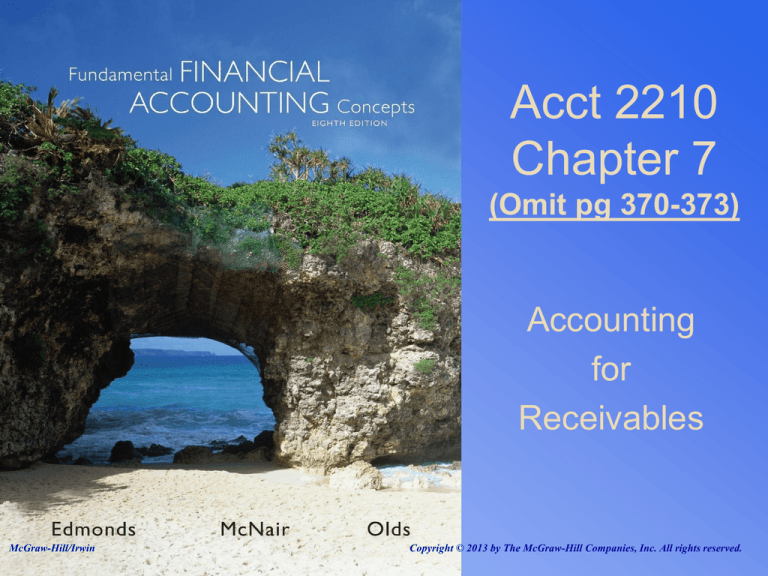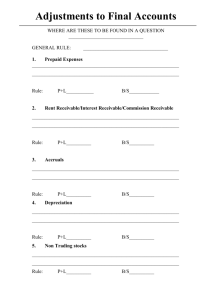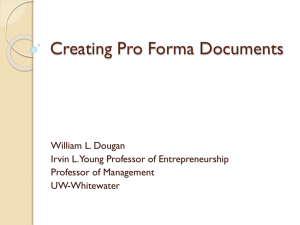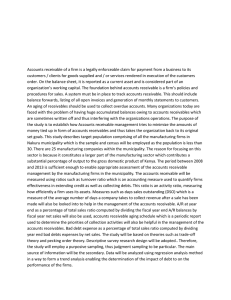
Acct 2210
Chapter 7
(Omit pg 370-373)
Accounting
for
Receivables
McGraw-Hill/Irwin
McGraw-Hill/Irwin
Copyright © 2013 by The McGraw-Hill Companies, Inc. All rights reserved.
LO 1
Explain how the
allowance method of
accounting for
uncollectible accounts
affects financial
statements.
7-1
Accounts Receivable and Notes
Receivable
When a company allows customers to “buy now and pay
later,” the company’s right to collect cash in the future is
called accounts receivable.
Individually, these
receivables are typically small and are payable within 30
days.
When a longer credit term is needed, or when the
receivable is large, the company usually requires the
customer to issue a note that specifies interest and
other credit terms. The company then records a note
receivable.
7-2
Credit Terms and Bad Debts
Some customers may be unwilling or unable to pay their
accounts receivable. As a result, we do not want to
overstate assets, and must show accounts receivable
at its “net realizable value” (NRV) on the balance sheet.
The NRV is the gross amount of the receivables less
some estimated “allowance for doubtful accounts”.
Multiplying the service revenue by the
percentage estimate of uncollectible
accounts is commonly called the “percent
of revenue method” of estimating
uncollectible accounts expense.
7-3
Revenue Recognition
Event 1 Revenue Recognition
During 2013, Allen’s Tutoring Services, a
service company, renders services on account
for customers in the amount of $14,000.
Event No.
1
Assets
= Liab.
14,000 = NA
+ Equity
+
14,000
Rev.
– Exp.
14,000 – NA
= Net Inc.
=
14,000
Cash Flow
NA
7-4
Collection for Receivables
Event 2 Collection of Receivables
During the year, ATS collects cash of $12,500 on
its accounts receivable.
Event No.
2
Assets
= Liab.
Cash
+ Accts. Rec.
12,500
(12,500) = NA
Total accounts receivable
Cash collected on accounts receivable
Balance in accounts receivable
+ Equity
Rev.
– Exp.
= Net Inc.
Cash Flow
+ NA
NA
– NA
= NA
12,500 OA
$
$
14,000
12,500
1,500
7-5
Recognizing Uncollectible
Accounts Expense
Event 3 Recognizing Uncollectible Accounts
Expense
Based upon past experience, ATS estimates
that $75 of its current accounts receivable
balance will eventually prove to be
uncollectible.
Event No.
3
Assets
= Liab.
(75) = NA
+ Equity
Rev.
– Exp.
+
NA
–
(75)
= Net Inc.
75 =
Accounts receivable
Less: Allowance for Doubtful Accounts
$
1,500
75
Net Realizable Value of Receivables
$
1,425
(75)
Cash Flow
NA
7-6
General Ledger Accounts
7-7
Financial Statements
Panel C Financial Statements for 2013
7-8
Subsequent Period
Event 1 Write-Off of an Uncollectible Account
Receivable
During 2014, ATS determines that an account
receivable of $70 will not be collected. The
company elects to write-off the account.
Event No.
1
Assets
Accts. Rec. (70)
= Liab.
+ Equity
Rev.
– Exp.
= Net Inc.
+ NA
NA
– NA
= NA
Cash Flow
Allow.
(70) = NA
NA
7-9
Revenue Recognition
Event 2 Revenue Recognition
During 2014, ATS renders services on account in the
amount of $10,000.
Event No.
2
Assets
= Liab.
10,000 = NA
+ Equity
+
10,000
Rev.
– Exp.
10,000 – NA
= Net Inc.
=
10,000
Cash Flow
NA
7-10
Collections on Account Receivable
Event 3 Collection on Accounts Receivable
During 2014, ATS collects $8,430 on its accounts
receivable.
Event No.
3
Assets
= Liab.
Cash
+ Accts. Rec.
8,430
(8,430) = NA
+ Equity
Rev.
– Exp.
= Net Inc.
Cash Flow
+ NA
NA
– NA
= NA
8,430 OA
7-11
Reinstate Account Receivable
Event 4 Reinstatement of Account Written-Off
Of the accounts receivable previously written off, it
turns out that the company will collect $10.
Event No.
4
Assets
Acct. Rec. 10
= Liab.
Allow.
10 = NA
+ Equity
Rev.
– Exp.
= Net Inc.
+ NA
NA
– NA
= NA
Cash Flow
NA
7-12
Recovery on Account
Event 5 Collection of Recovered Amount
Of the accounts receivable previously written off, it
turns out that the company will collect $10.
Event No.
5
Assets
Cash
= Liab.
+ Acct. Rec.
10
(10) = NA
+ Equity
Rev.
– Exp.
= Net Inc.
+ NA
NA
– NA
= NA
Cash Flow
10 OA
7-13
LO 2: Our focus will be the use of this
method of determining uncollectible accts.
Using the
“percent of
revenue” method
to estimate
uncollectible
accounts
expense.
7-14
Year-End Adjusting Entries
Event 6 Adjustment for Bad Debts Expense
At the end of 2014, ATS estimates that its bad debts
will amount to 1.35% of its service revenue.
Sales for 2014
Uncollectible percent
Uncollectible amount
Event No.
6
Assets
$ 10,000
1.35%
$
135
= Liab.
Acct. Rec. + Allow.
NA
135 = NA
+ Equity
Rev.
– Exp.
+
NA
–
(135)
= Net Inc.
135 =
(135)
Cash Flow
NA
7-15
General Ledger T-Accounts
7-16
Financial Statements
Panel C Financial Statements for 2014
7-17
LO 3
Students are NOT responsible for this method. It is shown
simply to indicate that two approaches could be used. Our focus
will be on the “Percent of Revenue” (LO 2) method only.
(OMIT pg 370-373)
Using the “percent
of receivables”
method to estimate
uncollectible
accounts expense.
7-18
Aging Schedule
7-19
Balance Required under the
Percent of Receivables Method
7-20
Computing Uncollectible Accounts
Expense
Required Allowance Balance
Less: Unadjusted Allowance Bal.
Uncollectible Accounts Expense
Account Title
Uncollectible Accts. Exp.
Allow. For D.A.
Assets
Accts. Rec.
NA
= Liab.
-
Allow.
3,260 = NA
$
Debit
3,260
3,760
(500)
3,260
Credit
3,260
+ Equity
Rev.
– Exp.
+
NA
–
(3,260)
$
= Net Inc.
3,260 =
(3,260)
Cash Flow
NA
7-21
LO 4 (Class Discussion Only)
Show how the Direct
write-off method of
accounting for
uncollectible accounts
affects financial
statements.
7-22
Direct Write-Off Method
Recall that in 2013, ATC recognized $14,000 of
revenue on account.
Event No.
Assets
= Liab.
Accts. Rec.
14,000 = NA
+ Equity
+
Rev.
14,000
Account Title
Accounts Receivable
Service Revenue
– Exp.
14,000 – NA
= Net Inc.
=
Debit
14,000
Cash Flow
14,000
NA
Credit
14,000
No entry will be made at year-end to estimate
uncollectible accounts expense if ATC believes
that amount will be immaterial.
7-23
Direct Write-Off Method –
Writing Off an Account
During 2014, the company determines that a
customer who owes $70 is unable to pay.
Event No.
Assets
= Liab.
Accts. Rec.
(70) = NA
+ Equity
Rev.
– Exp.
+
NA
–
(70)
Account Title
Uncoll. Accts. Exp.
Accounts Receivable
= Net Inc.
70 =
Debit
70
Cash Flow
(70)
NA
Credit
70
7-24
Direct Write-Off Method – Recovery of
a Written-Off Account
Also in 2014, ATC collects $10 from an account
that had been previously written off. ATC first
reinstates the account by reversing the write-off.
Assets
= Liab.
Accts. Rec.
10 = NA
+ Equity
+
10
Rev.
– Exp.
NA
–
Account Title
Accounts receivable
Uncollectible Accts. Exp.
= Net Inc.
(10) =
Debit
10
Cash Flow
10
NA
Credit
10
7-25
Direct Write-Off Method – Recovery of
a Written-Off Account
Once the account is reinstated, the event is recorded
the same as the collection of any other receivable.
Assets
Cash
= Liab.
+ Acct. Rec.
10
(10) = NA
+ Equity
Rev.
– Exp.
= Net Inc.
+ NA
NA
– NA
= NA
Cash Flow
10 OA
7-26
LO 5
Explain how
accounting for
notes receivable
and accrued
interest affects
financial
statements.
7-27
Accounting for a
Promissory Note
7-28
Notes Receivable
Event 1 Loan of Money
On November 1, 2013, ATS loans $15,000 cash to
Stanford Cummings. Cummings issues ATS a note
promising to repay the loan, with interest, in one
year.
Event No.
1
Assets
Cash
= Liab.
+ Notes Rec.
(15,000)
15,000 = NA
+ Equity
Rev.
– Exp.
= Net Inc.
+ NA
NA
– NA
= NA
Cash Flow
(15,000) IA
7-29
Interest Revenue
Event 2 Recognition of Interest Revenue
At the end of 2013, ATS must accrue the interest
earned on its note receivable (i.e. Nov – Dec, 2013).
$15,000 × 6% × 2/12 = $150 interest revenue
Event No.
2
Assets = Liab. + Equity
150
= NA
+
150
Rev.
150
– Exp. = Net Inc.
– NA
=
150
Cash Flow
NA
7-30
Collection of a Note Receivable
Event 3 Collection of Principal and Interest
On October 31, 2014, ATS collects the principal and
interest due on the note receivable. ATS first
recognizes interest revenue for the 10 months of
2014 (i.e. Jan – October, 2014).
$15,000 × 6% × 10/12 = $750 interest revenue
Event No.
3a
Assets = Liab. + Equity
750
= NA
+
750
Rev.
750
– Exp. = Net Inc.
– NA
=
750
Cash Flow
NA
7-31
Collection of a Note Receivable
Event 3 Collection of Principal and Interest
Now that the entire $900 of interest receivable has
been accrued, ATS records the collection of $15,900
in principal and interest on the note.
Account Title
Cash
Notes receivable
Interest receivable
Event No.
3b
Debit
15,900
Credit
15,000
900
Assets = Liab. + Equity
Rev.
– Exp. = Net Inc.
Cash Flow
NA
NA
– NA
15,000 IA
900 OA
= NA
+ NA
= NA
7-32
LO 6
Explain how
accounting for
credit card sales
affects financial
statements.
7-33
Credit Card Sales
Rather than maintaining a credit-granting
department, many companies find it cost
beneficial to accept credit cards. The credit
card company deducts a fee, usually between
2% and 8%, from the gross amount of the
sales, and pays the merchant the net balance
(gross sales less credit card fee).
7-34
Credit Card Sales
Event 1 Recording a Credit Card Sale
ATS accepts a credit card in payment for services
of $1,000. The credit card company charges a fee of 5%
of the transaction.
Event No.
1
Assets
= Liab.
950 = NA
+ Equity
+
Account Title
Accounts Receivable
Credit Card Expense
Service Revenue
950
Rev.
– Exp.
1,000 –
Debit
950
50
= Net Inc.
50 =
950
Cash Flow
NA
Credit
1,000
7-35
Credit Card Sales
Event 2 Collection of a Credit Card Receivable
ATS collects the full amount due from the
credit card company.
Event No.
2
Assets
Cash
= Liab.
+ Acct. Rec.
950
(950) = NA
+ Equity
Rev.
– Exp.
= Net Inc.
+ NA
NA
– NA
= NA
Account Title
Cash
Accounts Receivable
Debit
950
Cash Flow
950 OA
Credit
950
7-36
LO 7
Explain the effects
of the cost of
financing credit
sales.
7-37
Accounts Receivable Turnover
Accounts Receivable
Sales
=
Turnover Ratio
Accounts Receivable
The longer it takes to collect accounts
receivable, the greater the opportunity cost
of lost income.
7-38
Days to Collect Receivable
Average Number of
365
Days to Collect
= Accounts Receivable Turnover Ratio
Accounts Receivable
This ratio often helps simplify the issues
surrounding the collections of accounts
receivable.
7-39
Operating Cycle
The operating cycle is the average time it takes a
business to convert inventory to accounts receivable plus
the time it takes to convert accounts receivable back
into cash.
7-40
End of Chapter Seven
7-41






